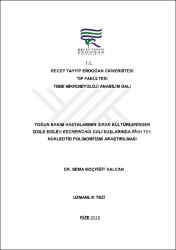Yoğun bakım hastalarının idrar kültürlerinden izole edilen escherichia coli suşlarında fimh single nükleotid polimorfizmi araştırılması
Özet
Üriner sistem enfeksiyonu (ÜSE), insanlarda en sık morbiditeye yol açan ve sağlık alanında ciddi harcamalara neden olan enfeksiyonlardan biridir. Üriner sistem enfeksiyonları üriner sistemin farklı bölümlerini etkiler ve enfeksiyon bölgelerine göre çeşitli hastalık gruplarına ayrılır. Asemptomatik bakteriüriden, sepsise yol açabilecek akut piyelonefrite kadar değişebilen çok farklı klinik formları tanımlar. Üriner sistem enfeksiyonları nozokomial enfeksiyonlar içerisinde de sıklık açısından birinci sırada yer alır. Yoğun bakım ünitelerinde pnömonilerle beraber en sık görülen iki enfeksiyondan biridir. Üropatojenik Escherichia coli suşları, üriner sistem enfeksiyonu geçiren hastaların yaklaşık %80'inde birincil patojen olarak kabul edilmektedir. Bakterilerin konak hücrenin yüzeyine yapışması; kolonizasyonun ve enfeksiyonun asıl başlangıç aşamasıdır. Tip1 fimbria adezyonu, üropatojenik Escherichia coli'lerin üriner sistem epiteline yapışma mekanizmasında çok önemli olan ve en iyi tanımlanan bakteriyel adezyonlardır. FimH proteini Tip1 fimbrianın ucunda yer alan yapışma proteinidir ve üriner sistemde üropatojenik Escherichia coli 'lerin patogenez mekanizmasında önemli bir rol oynar. İdrar yolunun epitel hücrelerinde bulunan ?-D-mannosile edilmiş glikoproteinlere bağlanmaya aracılık eder. FimH alt ünitesinin farklı fenotipik varyantları üriner sistemin kolonizasyonunda ve üriner sistem enfeksiyonu patojenitesinde bakterilere önemli avantajlar sağlar. FimH' nın fenotipik varyantları temel olarak fimH genindeki tek nükleotid polimorfizmlerinin (SNP) sonucudur. Çalışmamızda yoğun bakım hastalarının idrar kültürlerinden izole edilen E.coli suşlarında fimH gen bölgesindeki olası SNP'lerin belirlenmesi amaçlanmıştır. Çalışmamıza Haziran 2017-Haziran 2018 tarihleri arasında Recep Tayyip Erdoğan Üniversitesi Eğitim Araştırma Hastanesi Mikrobiyoloji Laboratuvarına enfeksiyon süphesi ile dahiliye yoğun bakım, cerrahi yoğun iii bakım, koroner yoğun bakım, kalp damar cerrahisi yoğun bakım, anaesteziyoloji ve reanimasyon yoğun bakım ünitelerinden gönderilen idrar örneklerinden üreyen 34 E.coli suşu dahil edildi. fimH pozitif suşlara dizi analizi yapıldı. Sekans sonuçları, Escherichia coli ATCC 700415 referans suşu kullanılarak; Clustal 2.1 Multiple Sequence Alignment' te filogenetik analiz yapıldı. 34 E.coli suşundan 32 sinde fimH pozitif bulundu. 100-500 bp arasında toplam 42 polimorfik bölge saptandı. Bu SNP'lerin bakterinin virulansına ne tür bir katkı sunduğunu göstermek için daha ileri çalışmalar yapılması gerekmektedir. Bizim yaptığımız çalışmanın ışığında, FimH proteinlerinin aminoasit dizi analizinin yapılması ve ortaya çıkan değişikliklerin üriner sistemin epitel hücrelerine yapışma eğilimleri üzerine etkisinin belirlenmesinin patogenezin anlaşılmasına çok büyük katkılarının olacağına inanmaktayız. Urinary tract infections (UTI) are among the most common causes of morbidityin humans and cause serious expenditures in healthcost. UTI affect different parts of the urinary system and are divided in to disease groups accordingly. UTI identify very different clinical forms which may vary from asymptomatic bacteriuria to acute pyelonephritis which may lead to sepsis. UTI rank first in terms of frequency among nosocomial infections together with pneumonia, they are the most common infections in intensive care units. Uropathogenic Escherichia coli strains are considered as the primary pathogens in approximately 80% of patients with UTI. The initial stage of colonization and infection involve bacteria adhering to the surface of the host cell. The type 1 fimbria of uropathogenic Escherichia coli is the most important and well-defined bacterial structure facilitating adhesion to the urinary tract epithelium. The tip of the type 1 fimbria is formed by the fimH protein, which is one of the virulence factors for uropathogenesis. FimH mediates the binding of Type 1 fimbria to the ?-D-mannosylated glycoproteins in the epithelial cells of the urinaryt ract. Different phenotypic variants of the FimH subunit provide significant advantages to bacteria in the colonization and the pathogenesis. Phenotypic variants of FimH result mainly from single nucleotide polymorphisms (SNP) of the fimH gene. In our study, it was aimed to determine possible SNPs in the fimH gene region in E.coli strains isolated from urine cultures of intensive care patients. In this study, 34 Escherichia coli strains were isolated from urine samples sent from the intensive care units of internal medicine, surgery, cardiology, cardiovascular surgery, anaesthesiology and reanimation with suspicion of infection to the Microbiology Laboratory between June 2017 andJ une 2018 were included. Sequencing was performed for the fimH positive strains. Using the sequence of Escherichia coli ATCC 700415 as v reference, phylogenetic analysis was performed in Clustal 2.1 Multiple Sequence Alignment. fimH was positive in 32 of 34 E. coli strains. A total of 42 polymorphic regions were detected that lied between 100-500 bp. Further studies are required to demonstrate the extent to which these SNPs contribute to the virulence of bacteria. In light of this study, we believe that the amino acid sequence variations of the FimH proteins can be matched with their adherence potency to th epithelial cells and thus their contribution to uropathogenesis.


















